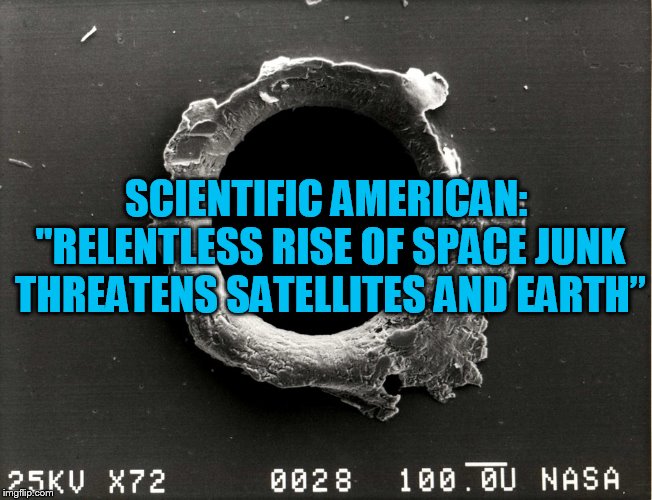 By B.N. Frank
By B.N. Frank
High-speed internet connections can be achieved via safer and more secure methods than wireless radiation-emitting satellites. Additionally, experts continue to warn that launching more vehicles – including broadband satellites – into an already overcrowded space will create more problems including a higher risk of human fatalities (see 1, 2)! In fact, the Federal Aviation Administration (FAA) just announced another warning about fatalities, particularly from Starlink satellite debris.
From Ars Technica:
SpaceX says FAA is wrong about Starlink satellite debris falling to Earth
SpaceX disputes FAA claim, says Starlink satellites fully burn up in atmosphere.
SpaceX is disputing a Federal Aviation Administration report to Congress on the risk of Starlink satellite debris falling to Earth, alleging that the FAA “relied in error on a deeply flawed analysis that falsely characterizes reentry disposal risks associated with Starlink.” The analysis used by the FAA “reflects nothing more than the culmination of several egregious errors, omissions, and incorrect assumptions—and it should be dismissed,” SpaceX said.
The FAA’s report to Congress on the “risk associated with reentry disposal of satellites from proposed large constellations in low Earth orbit” was made public on Thursday last week. The Starlink operator responded yesterday in a letter that SpaceX shared with Ars.
“SpaceX writes to correct the record and address inaccurate assessments regarding Starlink,” stated the letter sent to the Department of Transportation, FAA, and leaders of the Senate and House appropriations committees. SpaceX also said it “respectfully requests that FAA correct its report to Congress.”
Activist Post is Google-Free — We Need Your Support
Contribute Just $1 Per Month at Patreon or SubscribeStar
Among other things, SpaceX said the FAA’s debris estimates were based on a 23-year-old study of satellites that were made with different materials than Starlink satellites. SpaceX says its own satellites are designed to burn up completely when they reenter the atmosphere.
SpaceX has launched over 5,000 Starlink satellites into low-Earth orbits (LEO) and taken a few hundred out of orbit. “SpaceX satellites fully demise. Indeed, SpaceX has already deorbited 325 of its satellites since February 2020 with zero pieces of debris found,” the SpaceX letter said.
As the FAA letter notes, the Federal Communications Commission regulates the reentry risk of spacecraft within its jurisdiction, such as satellites. The FCC accepted SpaceX’s representation that its reentering satellites will produce no debris. But the FAA relied on a different analysis.
FAA alleges risk of death from falling debris
For its report to Congress, the FAA commissioned an analysis from Aerospace Corporation, a nonprofit that operates a federally funded research and development center. Aerospace’s “more conservative approach” found a risk of falling debris from Starlink, the FAA report said:
According to the Aerospace technical report, the annual probability of one or more people on an aircraft being hurt or killed due to a collision with space vehicle debris in 2021 was 0.1 percent. This is highly dependent on the amount of reentering debris. The largest constellation of satellites is the SpaceX Starlink constellation. SpaceX states its spacecraft are fully demisable, meaning zero surviving pieces. The FCC accepted the SpaceX orbital debris mitigation representation of zero debris. Aerospace assessed that the SpaceX spacecraft could each produce three pieces of debris of 300 grams. For purposes of this report, the FAA uses the more conservative approach.
Aerospace estimated that the risk to aircraft will “increase by well over 10 times the current risks” as satellite constellations grow larger and more satellites are taken out of orbit when they fail or reach end-of-life, the FAA said.
“If SpaceX Starlink does produce surviving debris as estimated by Aerospace, the Aerospace technical report states the probability of an aircraft impacted by a piece of reentry debris large enough to take down a single plane in a year worldwide would rise to 7 in 10,000 in 2035,” the FAA told Congress. “The corresponding expected casualty within an aircraft would be 8.4 out of 100. These are high numbers compared to today’s 1 in 1000 expected aircraft casualty probability.”
On potential deaths from debris falling all the way to the ground, the FAA said that “the risk to aviation remains below the expected ground casualty risks in 2035: a 6.1 out of 10. The Aerospace report indicates the annual chance of someone being killed as a result of space debris in 2035 would be 61 percent for a single death on the ground and a 0.07 percent chance of an aircraft downing event.”
But according to SpaceX, the analysis is “distorted” and based on data that isn’t applicable to Starlink satellites.
“Preposterous, unjustified, and inaccurate”
The SpaceX letter, written by Principal Engineer David Goldstein, said that Aerospace “has no special knowledge or insight regarding Starlink. Due to this lack of knowledge, a flawed methodology that omits critically important factors, and an over-reliance on an inapt and outdated NASA study, Aerospace has provided FAA with a distorted analysis that makes preposterous, unjustified, and inaccurate claims regarding Starlink disposal risk to people on the ground and to aviation. These errors may have been avoided if Aerospace had simply made basic inquiries with SpaceX, but it elected not to do so. In fact, Aerospace did not even seek to review the Starlink demisability analysis, which should have been a fundamental part of its analysis.”
SpaceX also faulted the FAA for not trying to verify the Aerospace analysis, saying the agency “accepted the Aerospace report without any scrutiny or diligence, and then distributed this incorrect information to Congress. The fact that FAA simply accepted the Aerospace report without question or scrutiny raises concerns regarding FAA’s technical competence to responsibly assess and regulate in this area.”
Aerospace used “assumptions, guesswork, and outdated studies relating to satellite constellations developed decades ago,” SpaceX said. The mistakes alleged by SpaceX include Aerospace relying on a 23-year-old NASA study of satellites that were made by the company Iridium with different materials than Starlink satellites.
“This analysis is inapplicable to SpaceX satellites because—among other things—lridium satellites were not even built to be fully demisable,” SpaceX said. “The Iridium satellites analyzed in the NASA study a generation ago are not similar in material, construction, design, orbit, and operation from SpaceX or any other modern satellite in LEO… Aerospace inaccurately oversimplifies the analysis to assume SpaceX’s satellites—which are designed to fully demise—are the same as the satellites NASA analyzed 23 years ago and that were not designed to fully demise. Aerospace then leaps from this false assumption to an indefensible conclusion that three objects from every SpaceX satellite will survive reentry. Aerospace provides no rational basis for basing its analysis on such an inexplicable assumption.”
SpaceX also criticized the FAA and Aerospace for “disregarding other satellite systems like Amazon’s Project Kuiper, OneWeb, or any of the LEO systems being developed and deployed by China.” The report to Congress claimed that “over 85 percent of the expected risk to people on the ground and aviation from reentering debris in 2035” comes from Starlink satellites, but SpaceX said that “claim has no basis in reality.”
SpaceX points to 99%+ success rate
The FAA report to Congress did include a caveat that said, “If SpaceX is correct in reporting zero surviving debris, as SpaceX reports in FCC filings, and Starlink is a fully-demisable spacecraft, the rise in reentry risk is minimal over the current risk.”
SpaceX said that caveat “is a key statement” and that “SpaceX engineers conducted extensive analysis that confirms that the satellites fully demise.” The “FAA bases its conclusions on a claim that the space industry has not met the 90 percent success rate for post-mission disposal, [but] SpaceX’s post-mission disposal success rate is greater than 99 percent. This critical and clearly pertinent fact is somehow omitted from both FAA’s report and the Aerospace Corporation analysis upon which it relies.”
The Aerospace analysis was apparently completed in 2021, but the FAA report was submitted to Congress on September 22, 2023. The report says that 54,902 LEO satellites will be in orbit in 2035, based on FCC approvals of Starlink and other constellations.
But SpaceX’s letter said the report wasn’t updated to account for a reduction in planned satellites since 2021. “Neither FAA nor Aerospace took any steps to update the outdated Aerospace findings to reflect updated FCC filings that actually reduced the number by 7,518 satellites prior to submitting this report to Congress,” SpaceX wrote.
When contacted by Ars today, the FAA said that it is “reviewing the letter” sent by SpaceX. Aerospace told us that its “technical team is in communication with SpaceX and others to review and update the data.”
Jon has been a reporter for Ars Technica since 2011 and covers a wide array of telecom and tech policy topics. Jon graduated from Boston University with a degree in journalism and has been a full-time journalist for over 20 years. Before Ars, he spent six years as a newspaper reporter and five years writing about technology for IDG’s Network World. To send Jon encrypted email, his public key is here; he can also be reached securely on Keybase.
In other Starlink news, it has been reported that subscriptions are lower than SpaceX predicted, speed has slowed down, and the satellites themselves are swerving every 10 minutes to avoid collision. Let’s not forget, in 2022, they also very noticeably fell from orbit and burned.
Other issues associated with broadband satellites
- They are making it almost impossible for astronomers to conduct research (see 1, 2)
- Launching them is REALLY bad for the environment
Despite all of the above, the FCC continues to approve the launching of tens of thousands of broadband satellites (see 1, 2) from Amazon, SpaceX, and others. That may be one of the reasons why it’s been labelled a “captured” agency (see 1, 2, 3, 4, 5, 6). Argh!
https://www.youtube.com/watch?v=zhAOEieqY5U
Activist Post reports regularly about broadband, space vehicles, and unsafe technologies. For more information, visit our archives.


Be the first to comment on "FAA Says Falling Starlink Debris Risks Lives; “54,902 LEO satellites will be in orbit in 2035, based on FCC approvals”"